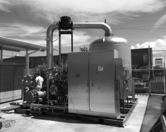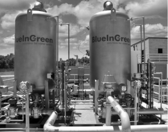
ABOUT CHARTWATER
ChartWater: A global manufacturer and service provider of engineered solutions for municipal water treatment and industrial process applications. Our portfolio of proven products, processes, and engineering expertise provides customers with single-point responsibility for complete solutions that enable water professionals to achieve their objectives with the lowest combination of risk and costs while driving enhanced outcomes for people, communities, and the planet.
FEATURED ARTICLES
-
Supersaturated dissolved oxygen (SDOX®) can cut aeration-related energy costs in half for a range of applications, including activated sludge systems, oxidation ditches, odor control in collection systems, and more.
-
This article will explain the matrix of factors that can affect PFAS removal and why it is important to work with an experienced partner.
-
This is the third article in a series of articles and case studies examining the adoption of innovative solutions in water treatment and the market drivers of change influencing how companies in various industries manage their wastewater.
-
This is the second in a series of articles and case studies examining the emergence of sustainably-driven innovation within the wastewater treatment functions of the food and beverage industry as sustainability and production issues intersect and influence how companies manage their wastewater.
-
When considering an arsenic treatment option for a water system application, it’s important to obtain and review the proposed design criteria carefully. A good system design will have evaluated critical water quality parameters.
-
Arsenic presents a wide array of negative health impacts, which is why it is such a big concern for many municipal water systems.
-
The aesthetic impact of iron and manganese on finished water — altering its color, odor, and/or taste — is the top driver of municipal utility customer complaints.
-
September 2020, water joined precious metals, oil and other commodity futures traded on Wall Street amid fears of scarcity. In October, Chart Industries, Inc., a global manufacturer of engineered equipment for the industrial gas and energy industries, announced its acquisition of the water cleantech company BlueInGreen, LLC., which Chart’s CEO and President, Jill Evanko, described as a ‘natural fit’.
-
Manganese has the potential to become a primary contaminant in the future. Therefore, cost-effective methods for removing it are an important consideration when treating drinking water.
-
Conventional nitrate treatment equipment tends to generate a waste-handling issue that can be a challenge to many utilities. The emergence of innovative technologies in drinking water treatment has led to more sustainable approaches for the reduction of nitrate.
-
The process of launching a municipal drinking water treatment operation can take years. In the end, a community is left with a complex system, an operations and maintenance manual, and a well-trained staff. Many communities are extremely well versed in the functions and operation of their treatment for the specific parameters for which it was built. However, as time goes on, plant managers and operators increasingly have a need for outside assistance.
-
Anion exchange treatment technologies produce a brine/contaminant discharge, while reverse osmosis solutions generate a concentrated arsenic reject. By comparison, the only cost of a properly designed iron-based adsorption system is periodic media changeout.
-
The city of Lemoore, CA, recruited a team of water treatment and construction specialists to address water quality and scarcity concerns.
-
Receiving a compliance order from the California Water Board’s Division of Drinking Water (DDW) was not the worst thing that ever happened to the City of Lemoore. It set the wheels in motion for a unique technical solution to historic groundwater problems and a progressive design-build approach to accelerating delivery of high-quality drinking water with only one-fourth the operating expense (OPEX) of other treatment alternatives.
-
Baby boomers are retiring in large numbers across many industries, and water isn’t immune to the shift. To adapt, AdEdge Water Technologies has been deliberate in its efforts to achieve staff diversity — especially the generational aspect — by crafting a culture to meet the expectations of younger workers.
-
Ammonia is a naturally occurring compound of nitrogen and hydrogen. As a key ingredient in many fertilizers, the most common way that it infiltrates source water and causes water treatment plant (WTP) problems is as agricultural runoff. Fortunately, new biological treatments can now handle ammonia and frequently co-occurring compounds such as iron and manganese all in one process.
-
Nature has long provided guidance to simple and sustainable ways to manage environmental challenges. Biological treatment of potable water is no exception. As more water is required to support human activity worldwide, sources once considered too contaminated or expensive to treat are quickly becoming necessary options. For groundwater contaminant removal, once again, the laws of nature point the way.
-
As fresh water supplies dwindle, search for “new water” increases, and regulations become more stringent, reverse osmosis systems have gained popularity among utilities. Their ability to treat brackish or salty water and to remove numerous contaminants provide opportunities to treat lower quality waters or reclaim treated effluent. Most concerns about reverse osmosis relate to high costs, concentrate management, and low recovery rates.
-
Basic construction activities today are more complex than ever when it comes to environmental concerns. Dewatering is a common necessity for contractors and developers today. In addition to ensuring a safe construction site, contractors must be aware of groundwater disposal constraints and regulations.
-
Few drinking water contaminants can boast the deadly reputation of arsenic. The substance is a well-known carcinogen associated with myriad health problems, and drinking water operations in certain regions must stay vigilant. To help in the fight against arsenic, Water Online spoke with Sahar Fathordoobadi, Application Engineer from AdEdge Technologies, an industry leader in arsenic removal solutions.
VIDEOS
-
Greg Gilles from AdEdge discusses trends in treatment and ways of tackling water scarcity in this episode of Water Talk.
-
Delano, a small town in California's Central Valley, was experiencing high nitrate levels in their groundwater. AdEdge, in conjunction with Carollo Engineers, designed, manufactured, and commissioned a biottta biological filtration system for nitrate removal rated for 570 gpm.
-
The Lincoln Pipestone Rural Water District in Minnesota had a high level of both nitrate and manganese in the groundwater. Piloting of the biottta treatment solution proved to be successful.
-
This video features testimony from Pete Gomez, Water Operator for Desert Sands MDWCA in Anthony, NM. In 2010, AdEdge installed a 450 gallons/minute AD26 Packaged Water Treatment system to remove arsenic, iron, and manganese in Andrews, NM.
CONTACT INFORMATION
ChartWater
1300 Airport Drive Ball Ground
Ball Ground, GA 30107
UNITED STATES
Contact: Clark Cambron
CASE STUDIES
-
Learn about a project to procure and fabricate large bore piping to reduce field installation.
-
Despite the large capital costs invested in a new pressurized CO2 feed system – a competing product to BlueInGreen’s supersaturated carbon dioxide gas-dissolution (CDOX®) technology — facility managers were unsatisfied with its performance
-
Learn how AdEdge water treatment experts took on the challenge of incorporating PFAS treatment into containerized designs that were already in progress.
-
In municipal wastewater facilities, the use of sulphuric acid to manage the pH of the wastewater in the buffering reactor tank prior to entering the DAF for solids and oil removal was considered to be an unnecessary risk requiring significant safety protocols.
-
BlueInGreen replaced two failed blowers and two SDOX units for Tyson Food's regional wastewater treatment plant without disrupting operations.
-
Discover several examples of utilities that successfully installed treatment systems to address the presence of iron and manganese.
-
At Schreiber Foods' wastewater treatment plant in Utah, mineral acids had been used for pH control in the past but were discontinued due to safety and handling issues. Facility owners desired a safer, more cost-effective solution that would provide automatic control over process pH levels.
-
Plant managers at Del Monte Foods in Siloam Springs, Ark. utilized a 14 million gallon facultative lagoon to provide treatment before applying the effluent on 500 acres of land nearby. However, the facultative lagoon was unable to meet the municipal pretreatment permit requirements, resulting in surcharges of $450,000 per month. Read the full case study to learn more.
-
The Plant’s wastewater treatment facility uses four, covered anaerobic lagoons to manage BOD, pretreating wastewater prior to sending the effluent to a pumping station which directs the wastewater into the municipal collection system for final treatment at the City’s wastewater treatment plant. Read more to learn how the company used hydrogen peroxide and a catalyst to maintain an aerobic environment but was unable to adequately mitigate the odor from the facility’s wastewater.
-
Wastewater from the meat processing facility is treated using a sequence batch reactor and an aerobic lagoon that discharges to surface waters following treatment. The facility replaced surface aeration equipment with two, 350-HP the “no-splash,” side-stream SDOX systems retrofitted to the treatment basin. Read the full case study to learn the results.
-
Officials at the Jefferson Parish Sewerage Department approached the team at Digital Engineering to find a long-term solution for the odor and corrosion issues throughout the East Bank Wastewater Treatment Plant.
-
After researching different ozone systems, plant officials ata 12 MGD wastewater plant in Arkansas chose to install BlueInGreen’s HyDOZ technology in order to more efficiently meet current permit requirements, as well as prepare for future legislation.
-
Learn how the Millsboro processing plant replaced mechanical surface aerators with SDOX technology to fulfill the oxygen needs of the various biological treatment processes without interrupting operations.
-
The wastewater pre-treatment plant processes effluent from the manufacturing facility prior to discharging into the sanitary sewer system for treatment at the municipal wastewater facility. Use of sulphuric acid to manage the pH of the wastewater in the buffering reactor tank prior to entering the DAF for solids and oil removal was considered to be an unnecessary risk requiring significant safety protocols.
-
AdEdge Water Technologies was engaged by Pharmaceutical Services & Installations (PSI) to provide a treatment option for the Century Packaging Corporation in Las Piedras, Puerto Rico.
-
When high levels of arsenic were found in the drinking water in the community of Alto Lampa outside of Santiago de Chile, municipal water provider Aguas Adinas faced a predicament. AdEdge Water Technologies was contacted to design a treatment approach. This case study describes how iron oxide adsorption helped Alto Lampa reduce arsenic levels in treated water to non-detectable concentrations.
-
AdEdge Water Technologies, LLC was contacted by Aqua Utilities Florida to provide a hydrogen sulfide removal system for the Lake Josephine community, located in Highlands County, FL. The treatment goal for the system was to reduce the levels of hydrogen sulfide to the nondetectable odor threshold of <0.05 mg/l.
-
When a food processing plant in Lancaster County, PA was forced to supply bottled water to its employees due to high nitrate levels in its raw water, they had no choice but to investigate a nitrate removal solution. In this case study you’ll learn how the plant avoided EPA violations by reducing nitrate contamination levels to below 8 mg/L and simplified continuous monitoring by implementing a new packaged nitrate removal system from AdEdge.
-
The emphasis on sustainability in recent years has placed an increased demand on environmentally friendly solutions that adhere to strict regulatory standards. The H2ZeroTM backwash/recycle system from AdEdge Water Technologies conserves water by storing and treating contaminated backwash water from filtration and treatment systems.
-
AdEdge Water Technologies, LLC was contacted by Great West Engineering to provide an arsenic and iron removal system for the Gore Hill County Water Treatment Plant Wells #1 and #2 in Great Falls, Montana.
-
In the fall of 2008, AdEdge was selected by Village of Corona, NM to design, manufacture, and startup a water treatment system for the removal of iron and manganese. By Adedge Technologies Inc.
-
In May 2007, AdEdge Technologies, Inc. was selected by Indian Health Services to supply an arsenic, iron, and manganese treatment system for the Bois Forte – Palmquist Community Water System in Minnesota. The system has two wells that combine together to serve potable water to 50 connections in the community. By Adedge Technologies
-
In June 2009, the Stewart County Water Company selected and began working with AdEdge Technologies to assist with the design and implementation of an Iron and Manganese treatment system to serve the water supply for Stewart County in Louvale, Georgia. By Adedge Technologies
-
In October 2005, AdEdge Technologies provided a proposal for the Red Mesa Unified School in Red Mesa, Arizona. AdEdge Technologies proposed a 75 gpm skid mounted system for the school that serves over 1000 students to reduce naturally occurring arsenic to meet the EPA maximum contaminant level (MCL) of 10 parts per billion (ppb). By Adedge Technologies
-
The Quail Ridge Community owns and operates the Quail Ridge Community water system located near Prescott, AZ. The water system is served by two wells that provide drinking water for the community’s residents at a maximum of 160 gallons per minute (gpm) with an approximate arsenic concentration of 13 parts per billion (ppb). By Adedge Technologies
-
The Middletown Springs Elementary School in Vermont is located in an area of the U.S. known to have groundwater containing elevated levels of naturally-occurring uranium. Due to the high levels of uranium detected in the well water serving the school, it was placed on a “Do-not-Drink Advisory”. By AdEdge Technologies
-
In the winter of 2006 AdEdge Technologies, Inc. was pre-selected to as the treatment vendor to provide a system for arsenic, iron and manganese removal at the Ohio Willow Wood Facility in Mount Sterling, Ohio. By Adedge Technologies Inc.
-
In July 2009, AdEdge Technologies Inc. (AdEdge) was contacted by Ladd Engineering, Inc. to provide a proposal for the Brandywine Elementary School in the Southern Hancock School District. By Adedge Technologies Inc.
-
In February 2009, the Melody Woods Water Company selected and began working with AdEdge Technologies to assist with the design and implementation of a Manganese, Iron and Turbidity treatment system to serve the water supply for Melody Woods in Los Gatos, California. By Adedge Technologies Inc.
-
AdEdge Technologies Inc. (AdEdge) was selected in 2006 by McCrone Engineers and the awarded contractor, Maryland Construction to design, build, and install a full scale AD26GS+ arsenic, iron, and manganese treatment system for their customer Foxxtown Apartments in Sudlersville, Maryland to meet the new EPA arsenic standard. By Adedge Technologies Inc.
-
AdEdge Technologies Inc. (AdEdge) was selected in 2007 by the U.S. EPA and the host site in Round 2a Arsenic Demonstration Program to implement a turnkey arsenic treatment for the Geneseo Hills Community in Geneseo, Il. The Geneseo Hills water system is served by one well with a design flow of 200 gpm, with a backup well. By Adedge Technologies Inc.
-
In January 2008 AdEdge Technologies, Inc. was selected among other vendors by Nationwide MHP to supply a turnkey arsenic, iron, and manganese treatment system for the Highland Hills MHP in Highland, Michigan. The system consists of multiple wells that combine together to serve potable water to 306 connections and a population of 765 in the community. By Adedge Technologies Inc.
-
In August, 2007 AdEdge Technologies, Inc. was selected among other vendors by Tri-County Drilling to supply an arsenic, iron, and manganese treatment system for the Lakeview Estates MHP in Durand, Michigan. By Adedge Technologies Inc.
-
In February 2008 AdEdge Technologies, Inc. was selected as the sole vendor by Sun Communities, a nation wide owner and operator of Mobile Home Communities, to supply an iron and manganese treatment system, for the Meadow Lake MHC in White Lake, Michigan. By Adedge Technologies Inc.
-
The Ramah Navajo Chapter owns and operates the Ramah Pine Hill water system located in Ramah, New Mexico. The water system is served by one well that provides drinking water for the community’s residents at a maximum of 130 gallons per minute (gpm) with an approximate arsenic concentration of 18 parts per billion (ppb) and iron concentration of 1.70 milligrams per liter (mg/L). By Adedge Technologies Inc.
-
Spring Canyon Ranch, LLC operates a community water system located in Quemado, New Mexico. Two water supply wells provide potable water to approximately 120 service connections. Groundwater enters the treatment system at approximately 40 gallons per minute (gpm) with arsenic concentrations of about 137 parts per billion (ppb). By Adedge Technologies Inc.
-
In February 2008 AdEdge Technologies, Inc. was selected as the sole vendor by Sun Communities, a nation wide owner and operator of Mobile Home Communities, to supply an iron and manganese treatment system, for the Meadow Lake MHC in White Lake, Michigan.
-
AdEdge Technologies Inc. was selected to design a full-scale arsenic treatment project using its Granular Ferric Oxide (GFO) adsorption technology...
-
AdEdge Technologies Inc. was selected to design a full-scale arsenic treatment project using its Granular Ferric Oxide (GFO) adsorption technology...
-
AdEdge Technologies Inc. was selected by Miller Water Association and Anvil Corporation to design a full-scale arsenic treatment project. Arsenic levels are alarmingly high at 0.18 mg/l, 18 times higher than the proposed new Federal standard of 0.01 mg/l. In addition to arsenic, many of the homeowners using the water objected to the sulfur odor resonating from the water.
-
Levine Fricke Engineers (LFE), an environmental firm under contract to Blackstone Consultants LLC (Blackstone), was responsible for specifying and selecting a cleanup remedy for a former contaminated nursery site located in Delray Beach, Florida...
-
In the early 2004, AdEdge was engaged by Pacific Advanced Civil Engineers (PACE) to devise a treatment alternative for manganese and iron removal for a public water system in southern California...
-
In 2003, AdEdge Technologies began working closely with EarthTech, the assigned engineering firm responsible for specifying and selecting the various water treatment systems serving the new National World War Monument in Washington, DC...
-
In early 2004, AdEdge was pre-qualified and invited to participate in arsenic pilot study of commercial adsorption-based treatment technologies with Damon S. Williams & Associates (DSWA)...
-
In May, 2003, upon approval by the County Health Department, Adedge Technologies in conjunction with its Michigan representative Artesian, Inc. installed the first arsenic treatment system for a Type II non-transient, noncommunity (NTNC) water system in Oakland County, Michigan...
-
In mid 2003, AdEdge was awarded 3 Arsenic Treatment Demonstration Projects with EPA. Implementation began in September, 2003 following approvals of the engineering submittals and permit by the New Hampshire Department of Environmental Services...
-
AdEdge was selected to implement 3 full scale Arsenic Treatment Demonstration Projects with EPA using its granular ferric oxide technology. At the Rimrock location, implementation began in September, 2003 including engineering submittals and permitting by the Arizona Department of Environmental Quality (ADEQ)...
WEBINARS AND PODCASTS
-
In this video Chart Industries' business leaders Tyler Elm and Greg Gilles provide an informative discussion on the different treatment options and technologies ChartWater offers to provide clean water for many different industries.
-
Perfluoroalkyl and polyfluoroalkyl substances (PFAS), a group of manmade chemical compounds are an example of an emerging contaminant that is attracting substantial attention of consumers, water professionals, and regulators due to their abundance in soil and drinking water sources, and their potential health effects. Accordingly, local regulation is already in effect in many states, and the EPA is taking measures to control the manufacturing, use, and exposure to PFAS and PFAS waste.
-
Recently, Rich Cavagnaro and Ronit Erlitzki, from AdEdge Water Technologies, sat down with the Water Online editorial team. The discussion ranged from ways to treat PFAS and water to sustainability to how to facilitate innovation in the water industry.
-
Chris Milligan, President of ChartWater – parent company to BlueInGreen and AdEdge – sat down with the Water Online editorial staff to discuss all things Chart, ChartWater, BlueInGreen, and the water industry as a whole.
-
The Central Valley of California has many potable groundwater systems operating on subsurface wells that have primary and secondary regulatory drinking water issues. Given the very challenging water quality as recognized the Division of Drinking Water, the City of Lemoore, CA water supply (consisting of multiple well clusters) is exceeding the compliance targets for disinfection byproducts (DBPs), mainly total trihalomethanes (TTHMs).
-
A southwestern (AZ) community faced a tough challenge to quickly identify an alternative water source and install a new and cost-effective treatment solution in a period of 6 months to provide potable water for the community during the temporary shutdown of the existing surface water treatment plants. This webinar will describe in detail the rationale and design criteria used to build the ultra-high recovery flow-reversal RO system used in this application.
-
The City of Taylorville, IL, needed to diversify their drinking water sources by bringing unused groundwater wells online to supplement their surface water supply. Unfortunately, their groundwater contained nitrate levels that exceeded regulatory limits and would require treatment.
-
For water utilities facing various water contamination issues, there is no single catch-all treatment. That is why in this recent Water Talk interview Ronit Erlitzki and Doug Craver of AdEdge Water Technologies share treatment options that can be used alone or in combination to address diverse challenges. They introduce a new reverse osmosis (RO) treatment technique capable of raising recovery rates by 20 percent and reducing concentrate volume up to 70 percent vs. conventional RO (depending on water quality). They also explore biological processes for removing nitrate, VOC, ammonia, etc. and treating high brine concentrations in wastewater, plus techniques for resolving ammonia problems in water with high TOC concentrations.
-
Arsenic, iron, manganese, and sulfide (AIMS) are common groundwater contaminants that have serious concerns both aesthetically and from a health perspective. Well-established treatment processes — oxidation/filtration and coagulation/filtration — are the industry standard for treating these contaminants; however, innovative medias can provide many benefits that traditional technologies lack, such as lower capital and operating costs.
-
There are a variety of technology vendors serving the water and wastewater industry, and many offer products and prices that are very comparable. Sometimes the differentiator comes down to the service, which is driven by company culture. In this Water Talk interview, Rich Cavagnaro, CEO of AdEdge Water Technologies, and Fariha Hassan, a project manager with AdEdge, discuss the positive ways to impact company culture and how that can go a long way toward impacting performance and innovation.
-
AdEdge Water Technologies specializes in inorganic contaminant removal, relying on a variety of treatment technologies such as adsorption, coagulation, oxidation, filtration, RO and ion exchange. Rich Cavagnaro, CEO of AdEdge Water Technologies and Ronit Erlitzki, Director of Business and Product Development for the Company, recently joined Water Talk to discuss a biological treatment technology for groundwater wells.
-
Biottta is a relatively new biological filtration process for drinking water treatment, addressing nitrates, perchlorates, chromium-6 and a number of VOCs as well. In this Water Online Radio interview, AdEdge Water Technologies’ Chad Miller and Rich Cavagnaro discuss its emergence in the water treatment market and some of the specific contaminants it addresses.
-
When Vinny Gupta, the president and CEO of InNow LLC, met Rich Cavagnaro, the CEO of AdEdge Water Technologies, he saw an opportunity to help 40 million people get clean water.
-
Carollo Engineers and AdEdge Water Technologies share insight and expertise while bringing innovative groundwater treatment systems to market.
-
There are a number of regulations in drinking water centered around emerging contaminants. Hexavalent chromium is one that you’ll see on the national marketplace.
-
The engineering community can sometimes be wary of trying anything other than the technologies they are already accustomed to, says Rich Cavagnaro of Adedge, a purification technology company with a focus on nitrates and radionuclides.
-
Rich Cavagnaro, President of AdEdge Water Technologies, and Tom Carmody, President of TC Tech LLC, share how their companies have partnered to successfully grow business in the advanced water treatment technology space.
-
Rich Cavagnaro and Greg Gilles, Principals of AdEdge Technologies, discuss the company’s water pot technology and a new movie about arsenic removal in a remote South American community
-
The president and vice president of AdEdge Water Technologies join Water Online Radio to discuss the company’s recent achievements and innovations, as well as the important differentiating factors for water treatment providers in today’s marketplace.
BROCHURES
- pH Control Informational Guide
- ChartWater Treatment Matrix
- PFAS Treatment Solutions - FLUORO-SORB Media
- GAC Small Scale Treatment Solutions
- WaterPOD
- Emergency Treatment Services (TaaS) For PFAS And Arsenic
- PFAS Treatment Solutions
- Odor Control: A Breath Of Fresh Air For Your Collection System
- Oxidation: Remove Substances You Can See -- And Others You Can't
- pH Adjustment: The Most Efficient CO2 Dissolution System
- Oxygenation: Next Generation Treatment. Today.
- Ultra-High Recovery Reverse Osmosis Brochure
- AdEdge Corporate Brochure
- NoMonia Biotreatment Solutions
- biottta® Biotreatment Packaged Plants Brochure
- biottta® Packaged Biotreatment Plants for Municipal Drinking Water Supplies
- biottta® Biotreatment Packaged Plants Sales Literature
- Media Replacement Services Datasheet
- AdVantEdge Full Line Brochure
- Packaged Residential Arsenic Adsorption Systems
- Under-Counter POU System For Arsenic Reduction: DWS-2S-2710-02 Datasheet
- Under-Counter POU System For Arsenic Reduction: DWS-4510-01 Datasheet
- InGenius Programmable Logic Controller Datasheet
- AdEdge Technologies APU Iron & Manganese Removal Systems Brochure
- WaterPOD™ Packaged Containerized Treatment Units Datasheet
- Adedge Modular Systems Datasheet
- H2Zero Backwash Recycle Systems Datasheet
- WaterPOD™ Packaged Containerized Treatment Units Brochure
- AdEdge APU Systems Brochure
- Brochure: Adedge Technologies Mining Projects Summary
- Datasheet: Integrated Membrane Solutions (IMS) Featuring Reverse Osmosis Packages
- Brochure: Integrated Membrane Solutions (IMS) Featuring Reverse Osmosis Packages
- Datasheet: AdEdge AD26 Series Systems
- Brochure: Adedge Arsenic Removal Solution For Small Water Systems
NEWS
- Chartwater™ And Calgon Carbon Announce Referral Agreement
- Chartwater™ And Delft Institute To Develop Water Treatment Solutions
- Chart Industries Announces The Formation Of ChartWater™ Division Within Specialty Products
- Experts Join Forces To Test The Efficiency Of Ozone In Eliminating The Virus
- AdEdge Increases Operations In Chile, Adds AdEdge Chile Business And Technical Manager And Latin America Sales Engineer To Staff
- AdEdge Adds Rotec LTD Flow-Reversal Reverse Osmosis Technology (FR-RO) To Core Product Offerings
- AdEdge Water Technologies Joins Endress+Hauser’s OEM Partner Program
- Executive Board Technology Award At 2017 National Federal Laboratory Consortium Awarded To United States Environmental Protection Agency And AdEdge Water Technologies Collaborative Technology Transfer
- AdEdge India Awarded Fluoride Project For 100 Sites In State Of Bihar
- AdEdge India Is Formed In Joint Venture Between AdEdge Water Technologies And InNow, LLC
- AdEdge India’s First Arsenic Treatment System Successfully Starts Up In West Bengal
- AdEdge Is A Finalist In The Metro Atlanta Export Challenge! Vote For Us Today!
- AdEdge Water Technologies Now Provides All Sizes Of Arsenic Treatment Systems
- AdEdge Water Technologies Awarded biottta® Nitrate Removal Project For The West Valley Water District, California
- Adedge Water Technologies Awarded Biottta Nitrate Removal Project For The City Of Delano, California
- AdEdge Adds Advanced Biological Treatment Technology To Core Product Offerings
- Rich Cavagnaro, President Of AdEdge Water Technologies, Named Metro Atlanta Chamber Of Commerce Business Person Of The Year
- Sam Miller Joins AdEdge Water Technologies As Mechanical Designer
- AdEdge Water Technologies Delivers Arsenic Treatment System To Chilean Community
- AdEdge Arsenic Treatment System Delivers Gift Of Clean, Arsenic Free Water To Argentine Village Plagued With 290 ppb Arsenic Concentrations
- AdEdge Water Technologies Awarded Contract To Provide Arsenic Treatment Systems For Spring Creek Utilities Company, Elko, Nevada.
- Esmeralda Bonilla Named Latin America Business Development Manager For AdEdge Water Technologies
- Doug Craver Joins AdEdge Water Technologies As Western Regional Sales Manager
- AdEdge H2Zero Recycle Backwash Systems Save Water And The Environment
- AdEdge Technologies Awarded Treatment System Project For The Resort Village Of Kannata Valley Saskatchewan, Canada
- AdEdge Technologies Inc. Launches New Web Site
- AdEdge Technologies Awarded Integrated Uranium And Arsenic Treatment System Project For The Tribal Community Of Campbell Ranch, NV
- AdEdge Technologies Awarded Three Round 2a Arsenic Treatment Demonstration Projects For Small Drinking Water Systems By The U.S. Environmental Protection Agency
- AD92 Uranium Adsorption Treatment System By AdEdge Technologies Effectively Treats Naturally Occurring Groundwater Uranium In Village Of Marshfield, Vt.
- AD26™ Systems from AdEdge Technologies Rapidly Gaining Popularity Among Small Water System Operators As Effective Solution For Co-occurrence Of Arsenic And Iron
- AdEdge Technologies Bayoxide® E33 Rated Top Performing Media In Recent SANDIA Pilot Test Report
- AdEdge Technologies Introduces AdVantEdge Residential Water Treatment Products
- AdEdge Technologies Installs 100th Public Water System For Arsenic Removal
- AdEdge Technologies AD26 Systems Remove Arsenic, Manganese and Iron
- USEPA Selects Adedge Technologies, Inc For Six Round 2 Arsenic Treatment






















































































